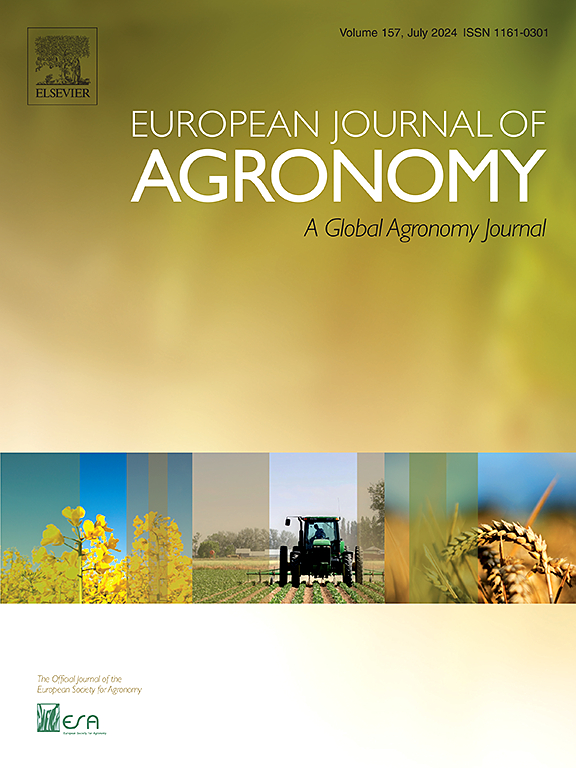Leveraging temporal variability in global sensitivity analysis of the Daisy soil-plant-atmosphere model
IF 4.5
1区 农林科学
Q1 AGRONOMY
引用次数: 0
Abstract
Dynamic crop models, such as the Daisy soil-plant-atmosphere model, simulate many processes and encompass a large number of parameters. Global sensitivity analysis (GSA) aims to identify the most influential parameters and understand model structure and behaviour. However, little attention has been paid to the temporal dynamics of parameter sensitivity in crop models, even though it can provide greater insight into model structure. This study performs a comprehensive GSA on the Daisy model, including the soil-vegetation-atmosphere transfer (SVAT) module, focusing on crop yield as well as CO2, N2O and energy fluxes. The Sobol’ method was applied to two types of outputs: (i) outputs aggregated into a scalar with an objective function (RMSE or cumulative) and (ii) vector outputs analysed at each time step. The main objectives of this paper were to compare the temporal and aggregated applications of GSA and to identify influential parameters of Daisy under different environmental conditions. Both aggregated and temporal methods identified the same main parameters. Nevertheless, temporal analysis provided deeper insight into model behaviour and calibration guidelines, revealing dynamic changes in parameter sensitivity at weekly and hourly resolutions and identifying critical periods for calibration. Aggregated analysis was less time-consuming and focused on specific aspects due to the definition of the objective function. Finally, we discussed the risks and solutions for Daisy over-parameterisation as well as methods for parameter estimation based on information provided by the GSA.
利用Daisy土壤-植物-大气模式全球敏感性分析中的时间变异性
动态作物模型,如Daisy土壤-植物-大气模型,模拟了许多过程并包含了大量参数。全局敏感性分析(GSA)旨在识别最具影响力的参数,了解模型的结构和行为。然而,很少有人关注作物模型中参数灵敏度的时间动态,尽管它可以更深入地了解模型结构。本研究对Daisy模型进行了综合GSA,包括土壤-植被-大气转移(SVAT)模块,重点关注作物产量以及CO2、N2O和能量通量。Sobol方法应用于两种类型的输出:(i)输出聚合为具有目标函数的标量(RMSE或累积)和(ii)在每个时间步分析的矢量输出。本文的主要目的是比较GSA的时间和聚合应用,并确定不同环境条件下雏菊的影响参数。聚合方法和时间方法都确定了相同的主要参数。然而,时间分析提供了对模型行为和校准指南的更深入的了解,揭示了参数灵敏度在每周和每小时分辨率下的动态变化,并确定了校准的关键时期。由于目标函数的定义,聚合分析更节省时间,并侧重于特定方面。最后,我们讨论了Daisy过度参数化的风险和解决方案,以及基于GSA提供的信息的参数估计方法。
本文章由计算机程序翻译,如有差异,请以英文原文为准。
求助全文
约1分钟内获得全文
求助全文
来源期刊

European Journal of Agronomy
农林科学-农艺学
CiteScore
8.30
自引率
7.70%
发文量
187
审稿时长
4.5 months
期刊介绍:
The European Journal of Agronomy, the official journal of the European Society for Agronomy, publishes original research papers reporting experimental and theoretical contributions to field-based agronomy and crop science. The journal will consider research at the field level for agricultural, horticultural and tree crops, that uses comprehensive and explanatory approaches. The EJA covers the following topics:
crop physiology
crop production and management including irrigation, fertilization and soil management
agroclimatology and modelling
plant-soil relationships
crop quality and post-harvest physiology
farming and cropping systems
agroecosystems and the environment
crop-weed interactions and management
organic farming
horticultural crops
papers from the European Society for Agronomy bi-annual meetings
In determining the suitability of submitted articles for publication, particular scrutiny is placed on the degree of novelty and significance of the research and the extent to which it adds to existing knowledge in agronomy.
 求助内容:
求助内容: 应助结果提醒方式:
应助结果提醒方式:


